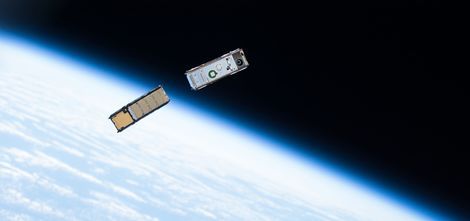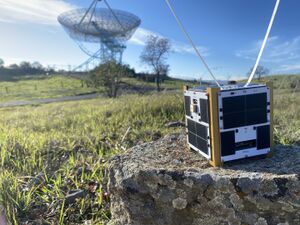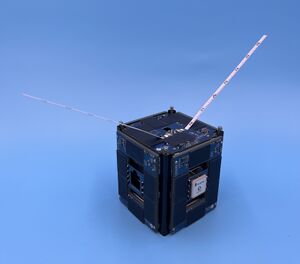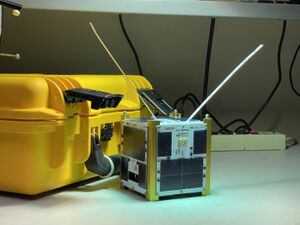Category:Satellites
Welcome to the SSI Satellites Team! Whether you're an incoming frosh, tired old senior, graduate student, alumni, or even not a part of the Stanford community, we're glad you're here. Our current mission is SAMWISE, a CubeSat with a huge number of technological advancements compared to our prior missions. Our Satellite Team Leads are
![]() @Niklas Vainio
@Niklas Vainio ![]() @Sage Wu
@Sage Wu ![]() @Hunter Liu
@Hunter Liu
Getting Started with Satellites
Stanford Affiliated ☀️
If you're a Stanford student, professor, or affiliate we'd love for you to join the SSI Sats community! Once you've joined our slack messaging hub, join the satellites channel and don't hesitate to reach out!
Outside Stanford ❄️
If you're not affiliated with Stanford but are interested in the team and our project, we'd still love to have you! Please email the team leads Ashley Raigosa, Spencer Wallace, or Theo Makler.
Onboarding Events Calendar
Check out the SSI Updated General Event Calendar to stay up-to-date on all of our onboarding events! This is still a work-in-progress so stay tuned for more information :)
Our Website: saplingsat.org
One of our main goals of the satellites team is to increase accessibility to space, and while we can have made a ton of progress on this from an engineering standpoint, it's pretty limited unless we get the word out. So we made a website! At saplingsat.org, you'll be able to find everything from our project overview to how to assemble our main flight computer. If you wanna take a deep dive into our software repositories or just brush up on terminology, the website is the place for you :)
Current Mission: SAMWISE
Our current mission is SAMWISE, a 2U CubeSat (10cm x 10cm x 20cm rectangle) with a bunch of super cool technologies. Stay tuned.
Subteams
Building a satellite is definitely not a simple task! There's a lot that goes into each one, so to help streamline things we divide up into subteams. Each of these subteams has a specific task associated with the satellite, and together they work together to make the mission a success! Below you'll find descriptions of each subteam, ways to contact our current subteam leads, and links to their respective Slack channels.
Attitude Determination and Control (ADCS)
Slack Channel: satellites-adcs
Subteam Lead: Grant Regen
Avionics
Slack channel: satellites-avionics
Subteam Lead: Hunter Liu
Payload
Slack channel: satellites-payload
Subteam Lead: Niklas Vainio
Software
Slack channel: satellites-software
Subteam Lead: Kien Deshpande
Structures
Slack channel: satellites-structures
Subteam Leads: Jacob Mukobi, Siolé Mayeski, and Jeremy Merritt
Systems Engineering
Slack channel: satellites-systems
Subteam Lead: kinda everyone!
Past Missions
Sapling Giganteum: 2022–2023
Also referred to as Sapling-2, this was the second of the Sapling series of 1U CubeSats (better descriptions to come + photos!)
Sapling Sempervirens: 2020–2023
Also referred to as Sapling-1, this was the first of the Sapling 1U cubesats (better descriptions to come + photos!)
Sequoia: 2019–2020
Sequoia was a planned 3U CubeSat that would demonstrate on-board image classification and processing with updateable machine learning models. The goal of the project was to obtain a high volume of scientifically important imagery for ecological and climatology research. Researchers many times have no need of images saturated with clouds or uninteresting areas—so why not filter them out with convolutional neural networks? We will retrain Sequoia’s deep learning with images taken by the satellite, uplinking improvements. SSI worked on developing deep learning models for forest fire risk assessment and detection and a number of other applications. The mission architecture is user definable with the operator specifying desirable image locations or types and resolutions, and the satellite maximizing delivery of fully open-source images.
Project materials can be found in the Sequoia GitHub.
POINTR: [year]–[year]
The Satellites Team developed various Optical Communications technologies, culminating in the launch of POINTR. This was a 1U segment of a 3U CubeSat launched in 2018, but it unfortunately never connected with ground control due to improper orbital insertion from the launch provider.
Additional Projects
In addition to projects taken on by the team as a whole, satellites members have worked in Stanford faculty labs to build:
- SNAPS, the Stanford NAno Picture Satellite, a 1/4U imaging CubeSat deployed from the ISS in 2016
- QB50 Discovery, Stanford's submission to an international 50-member CubeSat constellation
- Morgana, a CubeSat designed to study high energy particles in the upper atmosphere. (Cancelled)
Photos
If you've got a Stanford login you can take a look at our photos! The satellites photos can be found here.
Old Documentation
This team has been around for a long time! There's a lot of sub-pages on this wiki that are now redundant because of our website or are simply outdated. Until I figure out what to do with them I'll keep all the links in this section so we don't loose anything – Theo :)
Pages in category "Satellites"
The following 21 pages are in this category, out of 21 total.



